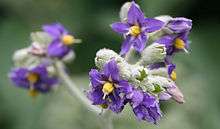Solanum mauritianum
- "Solanum auriculatum" redirects here. This name and Solanum mauritianum itself have variously been applied to other plants; see below.
| Solanum mauritianum | |
|---|---|
 | |
| Yellow ripe fruits eaten by birds | |
| Scientific classification | |
| Kingdom: | Plantae |
| (unranked): | Angiosperms |
| (unranked): | Eudicots |
| (unranked): | Asterids |
| Order: | Solanales |
| Family: | Solanaceae |
| Genus: | Solanum |
| Species: | S. mauritianum |
| Binomial name | |
| Solanum mauritianum Scop. | |
| Synonyms | |
|
See text | |

Solanum mauritianum is a small tree or shrub native to South America, including Northern Argentina, Southern Brazil, Paraguay and Uruguay.[1] It has become a widespread invasive weed in Azores Islands, Cook Islands, Fiji, Hawai‘i, New Caledonia, Norfolk Island, Solomon Islands, Tonga, Réunion Island, Mauritius, Madagascar, Australia, New Zealand, India, Sri Lanka[2] and several southern African countries.[3] Its common names include earleaf nightshade[4] (or "ear-leaved nightshade"), woolly nightshade, flannel weed, bugweed, tobacco weed, tobacco bush, wild tobacco and kerosene plant.
The plant has a life of up to thirty years, and can grow up to 10 m (33 ft) tall. Its large oval leaves are grey-green in color and covered with felt-like hairs. The flower is purple with a yellow center. The plant can flower year round but fruiting occurs in late spring to early summer. It is tolerant of many soil types and quickly becomes established around plantations, forest margins, scrub and open land.
As invasive species
Woolly nightshade has naturalized in New Zealand. It had arrived there by 1880, and is now well established from Taupo northward. Woolly nightshade is poisonous and handling the plants can cause irritation and nausea. The dust from the plant can cause respiratory problems if exposure is prolonged. Because of its ability to affect human health and because of its aggressive and fast growing character it is illegal in all areas of New Zealand to sell, propagate, or distribute any part of the plant.
This plant has also become naturalized in Australia, particularly on the east coast and in desert ranges (South Australia). In Australia this plant is known colloquially as "tobacco bush weed", although Australia possesses many species of Nicotiana which are more correctly known as wild tobaccos.
In South Africa, biological control is being used in an attempt to manage Solanum mauritianum[1] - the flowerbud weevil Anthonomus santacruzi is being used as a control agent. S. mauritianum is a favoured food plant of the African olive pigeon (Columba arquatrix),[5] the Cape bulbul, the Black-collared barbet, the Red-eyed dove and red-whiskered bulbul.[6]
Toxicity
It is alleged that all parts of the Solanum mauritianum plant are poisonous to humans, especially the unripe berries,[3] and furthermore that human fatalities have resulted from the consumption of the berries, and cases of fatal poisoning in pigs and illness in cattle have been reported in Queensland.[7] However, mountain possums appear to eat it without ill effect, and stripping of bark, leaves, and terminal shoots has destroyed pure stands of S.mauritianum. Watt & Brandwijk state that horses, domestic chickens and all birds eat the fruit with impunity, and further state that no records of poisoning in children exist, casting doubt on contrary published accounts.[8]
The main toxic compound is the alkaloid, solasodine, with the highest content in the unripe green berry (2-3.5% dry weight).[9] Solauricine, solauricidine, and solasodamine have also been found in Solanum mauritianum.[7]
Synonyms
The name Solanum mauritianum was applied by Blanco to S. erianthum and by Willdenow based on Roth to S. sisymbriifolium.[10]
In addition, wooly nightshade has a number of synonyms:[10]
- Solanum auriculatum Aiton
- S. auriculatum Mart. ex Dunal in DC. is S. granuloso-leprosum.
- Solanum carterianum Rock
- Solanum pulverulentum Salisb. (non L.: preoccupied)
- S. pulverulentum Nutt. ex Seem. is S. puberulum. Solanum pulverulentum Pers. is S. cutervanum.
- Solanum tabaccifolium Vell.
- Solanum verbascifolium var. typicum Hassl.
- Solanum verbascifolium var. auriculatum (Aiton) Kuntze
- Solanum verbascifolium var. auriculatum Maiden (non Aiton: preoccupied)
- S. verbascifolium L. is S. donianum; S. verbascifolium Banks ex Dunal in DC. is the same as the undeterminable S. stenorchis. Many other Solanum species (S. conglobatum, S. erianthum, S. granuloso-leprosum, S. hazenii, S. riparium, and S. stipulaceum Roem. & Schult.) were once considered varieties of the ill-defined "S. verbascifolium" too.
References
- 1 2 Olckersa, T., Zimmermann, H.G., "Biological control of silverleaf nightshade, Solanum elaegnifolium, and bugweed, Solanum mauritianum, (Solanaceae) in South Africa", Agriculture, Ecosystems & Environment, Vol. 37, Issues 1-3, October 1991, Pages 137-155
- ↑ Lalith Gunasekera, “Invaders In Knuckles Mountain Range”, Sri Lanka Guardian, October 2011, http://www.srilankaguardian.org/2011/10/invaders-in-knuckles-mountain-range.html. Accessed 19.6.2016.
- 1 2 Solanum Mauritianum Weed Profile, Global Invasive Species Database
- ↑ "Solanum mauritianum". Natural Resources Conservation Service PLANTS Database. USDA. Retrieved 17 November 2015.
- ↑ Gibbs, David; Barnes, Eustace & Cox, John. (2001): Pigeons and Doves. A&C Black, London. ISBN 1-873403-60-7
- ↑ http://www.issg.org/database/species/ecology.asp?si=1230
- 1 2 Everist, S.L., Poisonous Plants of Australia, Angus & Robertson, revised edition 1981, ISBN 0-207-14228-9
- ↑ "Medicinal and Poisonous Plants of Southern and Eastern Africa" - Watt & Brandwijk (Livingstone, 1962)
- ↑ Vieira, R.F., "Avaliação do teor de solasodina em frutos verdes de Solanum mauritianum Scop. sob dois solos no estado do Paraná, Brasil." MS theses. 1989. Curitiba, Universidade Federal do Paraná.
- 1 2 Solanaceae Source (2007): Solanum mauritianum. Version of August 2007. Retrieved 2008-09-28
External links
 Data related to Solanum mauritianum at Wikispecies
Data related to Solanum mauritianum at Wikispecies
| Wikimedia Commons has media related to Solanum mauritianum. |